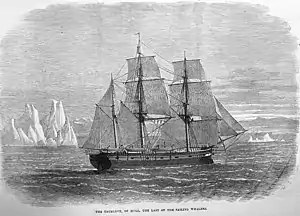Truelove (1764)
Truelove was a merchant ship, which served in the 18th and 19th centuries. The vessel was constructed in America in 1764, but was captured by the British in the American War of Independence, and operated as both a whaler and a general cargo ship until 1888, when she was broken up.
 Truelove in 1870 | |
| History | |
|---|---|
| United States | |
| Name | Truelove |
| Launched | 1764 |
| Fate | Captured by British |
| Great Britain | |
| Out of service | Around 1888 |
| Fate | Broken up |
| General characteristics | |
| Displacement | 400 tons |
| Tons burthen | 296 register tons |
| Length | 100 ft (30 m) |
| Beam | 30 ft (9.1 m) |
| Draught | 16 ft (4.9 m) |
| Sail plan | Full-rigged ship |
Description
Truelove was a full-rigged ship, with three masts and square rig. She was constructed with a "tumble home" design, with her hull sides (topsides) sloping inwards to the upper decks from the water line. Her topsides were constructed with planks overlapping in such a way as to allow water to drain freely from the upper decks. The ship's usual maximum speed was 8 knots (15 km/h). While operating as a merchant ship, she was fitted with twelve guns for defence against French attack.[1][2] The Truelove is commemorated with a sculpture in Hull by Stefan Gec.[3]
Service history
Truelove was launched in Philadelphia in 1764. The vessel was captured by the British during the American War of Independence, when she operated as an American privateer, and was bought by a shipowner for use as a cargo ship in the wine trade to Oporto. After a refit in 1784, which involved strengthening the vessel's hull, she began work as a whaler in the Arctic, based at Hull, although she was occasionally used for other cargo. In 1849, the ship carried relief supplies in support of Franklin's lost expedition, during which time she was threatened with sinking several times due to pack ice, including one instance when she was trapped for six weeks in Melville Bay.[4]
Notable whaling captains of the Truelove included John Parker, William Barron, and William Wells (1854-1860 & 1866-67)[5] The vessel retired from whaling in 1868, having completed 72 voyages. After this time, she was still capable of being used as a general cargo ship. She was eventually broken up, probably around 1888, after 124 years of near continuous service.[1][2][6][7]
References
- Ashley, Clifford Warren (1992). The Yankee whaler. p. 48. ISBN 978-0486268545.
- Barron, William. Old Whaling Days. pp. 198–201. ISBN 978-1110521555.
- "True Love Sculpture, Kingston Upon Hull". Flickr. Retrieved 2017-11-05.
- Goodsir, Robert (1969). An Arctic voyage to Baffin's Bay and Lancaster Sound in search of friends with Sir John Franklin (Second ed.). Plaistow & Sutton Coldfield: The Arctic Press. p. 118. ISBN 0952739402.
- "How the Truelove spent 130 years at sea - HEY Today". HEY Today. 2017-04-12. Retrieved 2017-11-05.
- Robert E. Hellman "Whaling Tools in the Nantucket Whaling Museum" Nantucket historical association
- Gibbons, Tony (2001). The Encyclopedia of Ships. Amber Books. p. 60. ISBN 978-1905704439.
External links
- Watercolour of Truelove of Hull by David Johnson Kennedy, at the Historical Society of Pennsylvania
- Oil painting of Truelove of Hull by William Robert Nixon